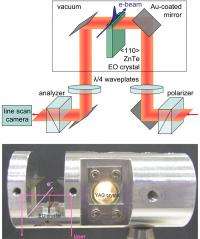(top) Schematic layout of the electro-optical arrangement. (bottom) The electro-optical module with a YAG crystal for electron beam position monitor.
(PhysOrg.com) -- Brookhaven researchers have developed a device that acts like a high-tech stopwatch for speedy packs of electrons just trillionths of a second long. This new diagnostic tool could aid in the development of x-ray free electron lasers (FEL), sources that produce pulses of light up to one billion times brighter and 1,000 times shorter than those produced at conventional storage ring light sources.
Like a high-speed strobe light, the ultra-short bursts of light produced from an FEL allow scientists to take stop-motion pictures of chemical reactions, biological processes, and various other atomic-scale events. FELs create this valuable x-ray light by shooting a series of ultra-short bunches of electrons through an array of specialized magnets. The shorter the electron bunches, the more powerful the resulting light.
"In recent years, the bunch lengths of electrons in accelerators have decreased dramatically, producing extremely bright pulses of light that are on the same time scale as vibrations in molecules and the creation or breakage chemical bonds," said NSLS researcher Xi Yang. "But in order to synchronize the time-dependent process being studied with the x-ray pulse, we need a new set of beam diagnostics."
So how do scientists measure the length of these picosecond-scale pulses? It's not easy. There have been previous successful attempts, but only with limited resolution and complicated steps.
At the NSLS Source Development Laboratory (SDL), Brookhaven researchers have demonstrated a high-resolution measurement system that's nondestructive to the electron beam and can be easily transported among facilities.
In the setup (first proposed by Brookhaven researchers in 2002), a beam of electron bunches is sent across the top edge of a thin, "electro-optical" crystal. Traveling at close to the speed of light, each electron bunch emits an electric field that travels downward through the crystal. At the same time, a single, line-focused laser pulse is sent straight through the broad side of the crystal, where sections of the laser line are encoded with spatial information from the electron bunches. A special camera at the end of the device collects this data.
"Using this monitor, we are able to take robust measurements of the electron bunch length," Yang said. "The tolerance on timing jitters can be many picoseconds."
The results were published in the December 7, 2009 edition of Applied Physics Letters.
Now, the goal is to measure electron pulses an order of magnitude smaller, in femtosecond duration, or quadrillionth of a second range. The Brookhaven researchers hope to accomplish this resolution enhancement by using a thinner crystal, which will minimize the smearing of the electron beam while the laser probe travels through the crystal, giving the encoded spatial information less time to "degrade." This detailed picture will let scientists analyze fine structures within the pulses, such as micro-bunching - the arrangement of electrons within a larger bunch.
More information: X. Yang, T. Tsang, T. Rao, J.B. Murphy, Y. Shen, X.J. Wang, "Electron Bunch Length Monitors Using Spatially Encoded Electro-Optical Technique in an Orthogonal Configuration,"Appl. Phys. Lett., 95, 231106 (2009).
Provided by Brookhaven National Laboratory






















